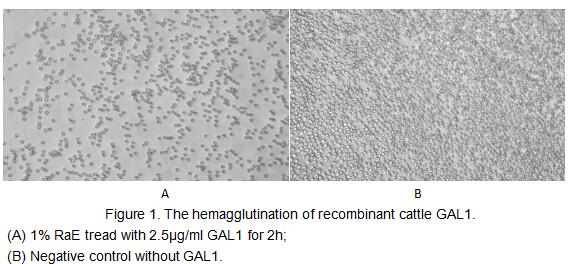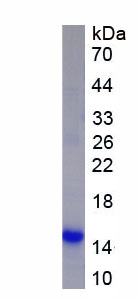Active Galectin 1 (GAL1) 

LGALS1; GBP; HLBP14; Galaptin; Lectin,Galactoside-Binding Soluble 1; 14 kDa laminin-binding protein; Lactose-binding lectin 1; Putative MAPK-activating protein PM12; S-Lac lectin
- UOM
- FOB US$ 346.00 US$ 864.00 US$ 1,728.00 US$ 5,184.00 US$ 12,960.00
- Quantity
Overview
Properties
- Product No.APA321Bo01
- Organism SpeciesBos taurus; Bovine (Cattle) Same name, Different species.
- ApplicationsCell culture; Activity Assays.
Research use only - DownloadInstruction Manual
- CategoryTumor immunity
- Buffer FormulationPBS, pH7.4, containing 0.01% SKL, 5% Trehalose.
- Traits Freeze-dried powder, Purity > 90%
- Isoelectric Point6.2
Sign into your account
Share a new citation as an author
Upload your experimental result
Review

Contact us
Please fill in the blank.
Activity test

Galectins are a family of carbohydrate-binding proteins with an affinity for beta-galactosides. Galectin-1 (GAL1) is differentially expressed by various normal and pathological tissues and appears to be functionally polyvalent, with a wide range of biological activity. The intracellular and extracellular activity of GAL1 has been described. Evidence points to GAL1 and its ligands as one of the master regulators of such immune responses as T-cell homeostasis and survival, T-cell immune disorders, inflammation and allergies as well as host-pathogen interactions.It also can agglutinate red blood. In this case, chose rabbit erythrocyte (RaE) to assay its ability of agglutination. A general procedure for hemagglutination assay (or haemagglutination assay; HA) is as follows, two-fold dilute the recombinant cattle GAL1 with 0.9% sodium chloride injection, add 50μL a serial dilution of GAL1 to each well of a U or V-bottom shaped 96-well microtiter plate. The final well serves as a negative control without GAL1, replace with 50μL 0.9% sodium chloride injection. Then add 50μL 1% rabbit erythrocyte to each well and mixed gently. The plate is incubated for 3 hours at room temperature. The results are shown in Figure 1. It was obvious that the minimal effective concentration of GAL1 is 2.5μg/mL.

Figure 2. The hemagglutination assay of GAL1 in V- bottom shaped 96-well microtiter plate.
Usage
Reconstitute in 10mM PBS (pH7.4) to a concentration of 0.1-1.0 mg/mL. Do not vortex.
Storage
Avoid repeated freeze/thaw cycles. Store at 2-8°C for one month. Aliquot and store at -80°C for 12 months.
Stability
The thermal stability is described by the loss rate. The loss rate was determined by accelerated thermal degradation test, that is, incubate the protein at 37°C for 48h, and no obvious degradation and precipitation were observed. The loss rate is less than 5% within the expiration date under appropriate storage condition.
Increment services
-
 BCA Protein Quantification Kit
BCA Protein Quantification Kit
-
 Molecular Mass Marker for Protein
Molecular Mass Marker for Protein
-
 Monoclonal Antibody Customized Service
Monoclonal Antibody Customized Service
-
 Polyclonal Antibody Customized Service
Polyclonal Antibody Customized Service
-
 Protein Activity Test Experiment Service
Protein Activity Test Experiment Service
-
 Electrophoretic Mobility Shift Assay (EMSA) Experiment Service
Electrophoretic Mobility Shift Assay (EMSA) Experiment Service
-
 Buffer
Buffer
-
 Lentivirus Packaging Experiment Service
Lentivirus Packaging Experiment Service
-
 Adenovirus Packaging Experiment Service
Adenovirus Packaging Experiment Service
-
 Real Time PCR Experimental Service
Real Time PCR Experimental Service
-
 Spike RBD Protein (S-RBD)
Spike RBD Protein (S-RBD)
-
 Protein G
Protein G
-
 Protein A
Protein A
Citations
- Galectin-1-mediated cell adhesion, invasion and cell death in human anaplastic large cell lymphoma: Regulatory roles of cell surface glycansPubmed:24589677
- Galectin-1 and galectin-3: plausible tumour markers for oral squamous cell carcinoma and suitable targets for screening high-risk populationPubmed:25578395
- Cord blood galectin-1 and-3 concentrations in term pregnancies with normal restricted and increased fetal growthPubMed: 24717333
- Noninvasive small-animal imaging of galectin-1 upregulation for predicting tumor resistance to radiotherapyPubmed:29272764
- Molecules of Damage-Associated Patterns in Bronchoalveolar Lavage Fluid and Serum in Chronic Obstructive Pulmonary DiseasePubmed:29429028
- Elevated level of Galectin-1 in bronchoalveolar lavage of patients with idiopathic pulmonary fibrosisPubmed: 31678459
- Galectin expression detected by 68Ga-galectracer PET as a predictive biomarker of radiotherapy resistancePubmed:35106644
- Regulatory T cells, damage-associated molecular patterns, and myeloid-derived suppressor cells in bronchoalveolar lavage fluid interlinked with chronic obstructive …Pubmed:35687771
- In Vitro Bovine Embryo Production Using Medium's Supplemented with Recombinant Human Galectin-1 Buffered







